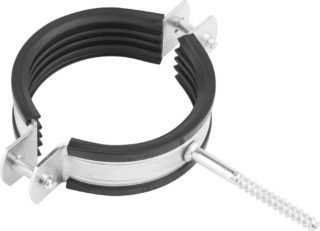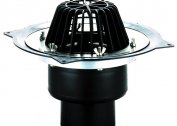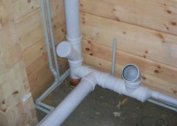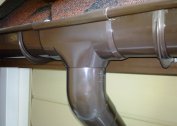During the installation of the sewer system, it is important to securely fix the pipeline. This will increase its life and reduce the possibility of damage and breakouts.
The main methods of fastening sewer pipes
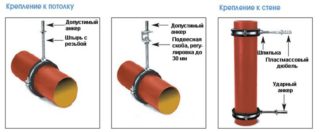 Small section sewage pipes can be attached to the walls using plastic clips. As a rule, fasteners of this type are used for pipe sections with a cross section of up to 50 mm. They are inserted into the clip and snaps securely. It is impossible to fix the sewer pipe with a diameter of 110 mm in this way. For these purposes, there are special mounts consisting of two plastic or metal half rings connected by two screws. Fasteners are mounted on the wall using a self-tapping screw and dowel.
Small section sewage pipes can be attached to the walls using plastic clips. As a rule, fasteners of this type are used for pipe sections with a cross section of up to 50 mm. They are inserted into the clip and snaps securely. It is impossible to fix the sewer pipe with a diameter of 110 mm in this way. For these purposes, there are special mounts consisting of two plastic or metal half rings connected by two screws. Fasteners are mounted on the wall using a self-tapping screw and dowel.
To fix the plastic pipes, you can use special brackets. They are equipped with fasteners that do not allow displacement of vertically arranged pipe segments, for example, fan ones.
Such a mounting option as hook-and-hangers is only suitable for connecting sewer pipes to the ceiling.
Most often, the fastening of sewer pipes to a wall or other supporting surface is carried out by means of special elements - clamps. They come in the following varieties:
- Crimp. The principle of operation is to fix and crimp the joints and fittings. Allow to ensure the tightness of the system.
- Guides. They are used for sewage pipelines mounted on supporting surfaces using markers and fasteners.
- Supporting. Contribute to the fixation of the pipeline to the wall. Equipped with vibration compensators made of rubber, which additionally protect against damage.
- Safety They are used if installation of additional fasteners is required on a difficult site.
Plumbing clamps are classified according to another principle - the material used for their production. Metal products contribute to the implementation of extremely rigid and powerful fixation. Plastic models made of polypropylene or PVC allow you to create not only a “dead” fastening of the pipe section, but also to make a movable connection. They are practical and inexpensive.
Guidelines for choosing a mounting method
The mounting scheme on the supporting surface can be floating and rigid. In the first embodiment, the fasteners are carried out by means of guides and supporting clamps fixing the cross-section of the screed. In the second, it is performed using a crimping and supporting element, they are put on a shaped part and a bell-shaped section. Serve to combine pipe segments and fitting parts. The second version of the fastener is made in order to preserve the integrity of the pipes during thermal deformations.
For rigid fasteners, a collar corresponding to the cross section of the pipe is selected. In places where it is only necessary to preserve the axial direction of the pipeline, products with a large diameter are used to compensate, if necessary, the thermal stretching of the plastic line.
It is necessary to select fastener options taking into account the design features of the room. Plastic clamps are suitable for places with open sewers. If the fan trunk is hidden, the main criteria for selecting fasteners for fixation are its immobility or mobility, deafness or freedom when stretched.
Rules for installing sewer fasteners
To fix the highway efficiently, consider certain nuances:
- Location of fixtures.Fasteners are placed where the sewer line bends, branches, as well as in the places of installation of reinforcing elements and connecting nodes. To correctly calculate the location of the clamps, you will need to pre-compile a general layout of the laying of the sewer line with all the branches. The drawing can be transferred directly to the walls of the room.
- The slope of the pipes. According to building codes, it is at least two centimeters per linear meter of the highway. At the same time, it is necessary to avoid turns at an angle of 90 degrees, which are the most risky areas in terms of clogging the sewer system.
- Alternating non-slip and floating fasteners. Each pipe section must be fixed with at least one rigid fixed clamp. It is located at the base of the pipe, where it connects to the remaining elements of the sewer. At the same time, floating clamps should be installed - on both sides of the fixed.
- The distance between the fasteners. When installing sewer lines made of plastic or metal plastic, their fastening is carried out with a distance of two meters between the clamp elements. If you plan to install a heavy pipeline of steel or cast iron, clamps are exposed more often, in increments of one and a half meters.
- Reliable fixation to the ceiling or wall. Plumbing lines are constantly under load, they are affected by vibration and temperature changes. Without reliable fastening, the pipeline can collapse. It should be checked that the hardware of the fasteners are firmly held in the supporting surfaces, without painting and cracking.
If there are doubts about the reliability of fastening the fastener, you will have to change the initial design of the pipeline.
Step-by-step installation guide
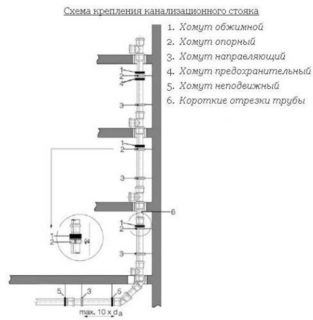 When installing sewer equipment, pipe sections are fastened in the following sequence:
When installing sewer equipment, pipe sections are fastened in the following sequence:
- By means of fasteners of fittings and joints, branches are laid to the heated zone. The pipeline is rigidly fixed.
- Floating support parts with linear expansion joints are fixed. They protect the line from vibration and deformation even with possible linear expansion.
- After applying axial sewage lines to the walls, a pipeline is laid. According to the marks, guide fasteners are placed, and the pipe is laid. The slope of the pipe segments and the number of shaped elements for the sewer system are also determined.
- Fittings are installed with fixation by supporting and crimping fasteners in order to avoid negative vibration and temperature effects.
- When installing a new system, the line is inserted into the clamp part in the form of the letter “U” and is applied to a collapsible screed. The bolt lock is tightened. Do not over-tighten collapsible fasteners before the sewer system is completely installed.
- Support parts are mounted by the number of joints and fittings. An empty area without shaped elements is fixed with clamps of a guide and a protective type.
Even more reliably than the clamps, the trunk is fixed in the strobe, which acts as a channel for laying the tubular product. If you mount the pipeline in a special channel in the wall, this will securely fix it and will not spoil the design of the room.
Modern fasteners are structurally adapted to mount them and the entire pipeline as a whole was not difficult. To install any kind of mounts, you do not need to use specialized tools or professional skills.
